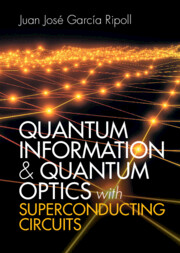Book contents
- Frontmatter
- Contents
- Figures
- Tables
- Notation
- 1 Introduction
- 2 Quantum Mechanics
- 3 Superconductivity
- 4 Quantum Circuit Theory
- 5 Microwave Photons
- 6 Superconducting Qubits
- 7 Qubit–Photon Interaction
- 8 Quantum Computing
- 9 Adiabatic Quantum Computing
- Appendix A Hamiltonian Diagonalizations
- Appendix B Open Quantum Systems
- References
- Index
7 - Qubit–Photon Interaction
Published online by Cambridge University Press: 04 August 2022
- Frontmatter
- Contents
- Figures
- Tables
- Notation
- 1 Introduction
- 2 Quantum Mechanics
- 3 Superconductivity
- 4 Quantum Circuit Theory
- 5 Microwave Photons
- 6 Superconducting Qubits
- 7 Qubit–Photon Interaction
- 8 Quantum Computing
- 9 Adiabatic Quantum Computing
- Appendix A Hamiltonian Diagonalizations
- Appendix B Open Quantum Systems
- References
- Index
Summary
Almost all superconducting quantum technologies are built using a combination of qubits and microwave resonators. In this chapter, we develop the theory to study coherent qubit–photon interaction in such devices. We start with the equivalent of an atom in free space, studying a qubit in an open waveguide. We develop the spin-boson Hamiltonian, with specific methods to solve its dynamics in the limits of few excitations. Using these tools, we can study how an excited qubit can relax to the ground state, producing a photon, and how a propagating photon can interact with a qubit. We then move to closed environments where the photons are confined in cavities or resonators, developing the theory of cavity-QED. Using this theory, we study the Purcell enhancement of interactions, the Jaynes–Cummings model, Rabi oscillations, and vacuum Rabi splitting. We close the chapter illustrating some limits in which cavities can be used to control and measure qubits.
Keywords
Information
- Type
- Chapter
- Information
- Publisher: Cambridge University PressPrint publication year: 2022
